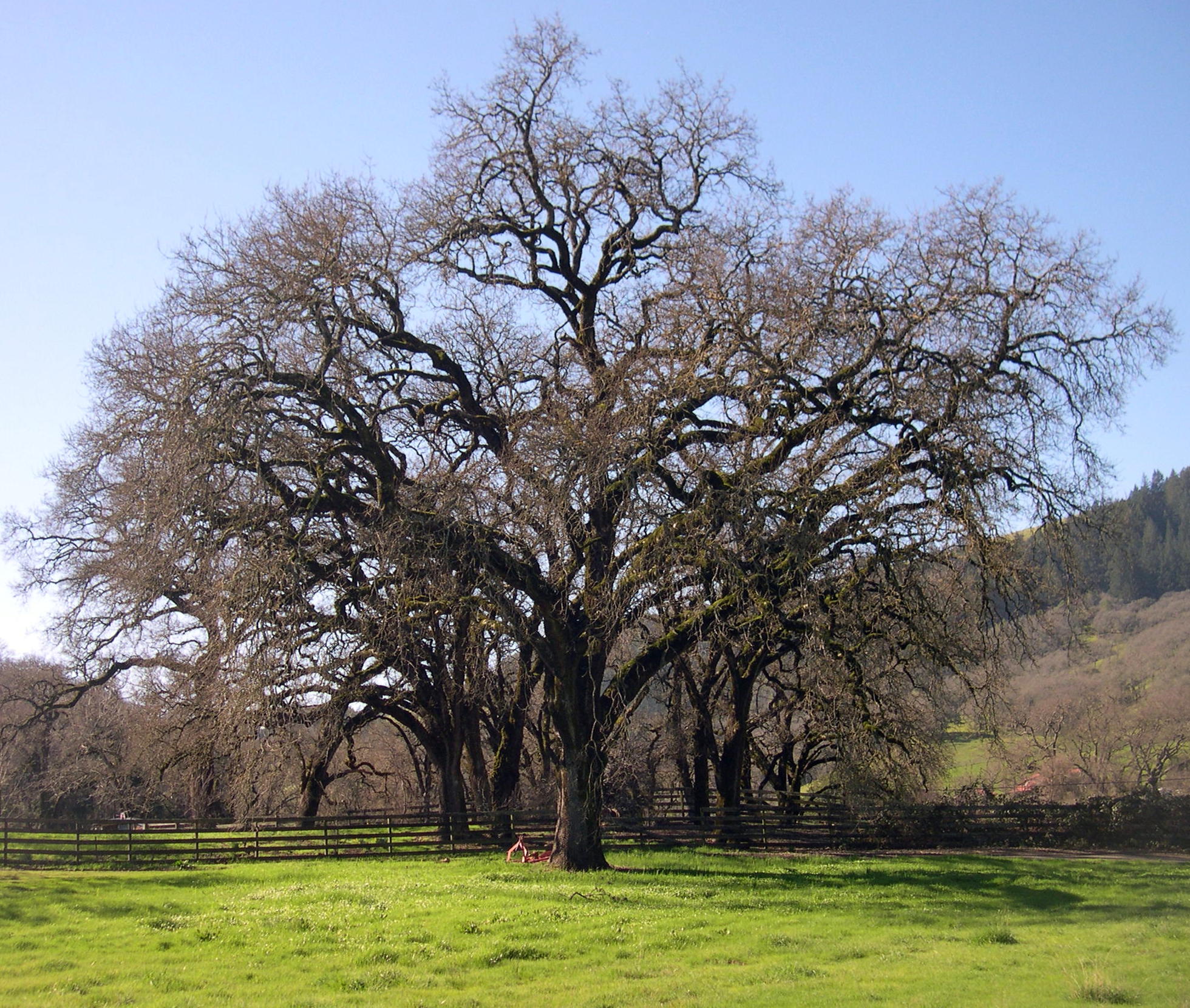- Quercus lobata
Taxobox
name = Valley oak

image_width = 200px
image_caption = Valley Oak,Sonoma County ,California
regnum =Plant ae
divisio = Magnoliophyta
classis =Magnoliopsida
ordo =Fagales
familia =Fagaceae
genus = "Quercus "
sectio = "Quercus"
species = "Q. lobata"
binomial = "Quercus lobata"
binomial_authority = NeeThe Valley oak "(Quercus lobata)" is the largest of North American oaks.
It ranges over the hot interior valleys of California. Mature specimens may attain an age of up to 600 years. This
deciduous oak requires year-round access to groundwater.Its grand stature was noted by early pioneers. Today it is an attractive addition to the California landscape.
Its thick, ridged bark is characteristic and evokes
alligator hide. The Valley oak's felt-like deeply lobed leaves assist in rapid identification.Description and ecology
The sturdy trunk of the Valley oak may exceed two to three meters in diameter and its towering stature may surpass 30 meters in height. The branches have an irregular, spreading and arching appearance that produce a profound leafless silhouette in the clear winter sky. In advancing age the branches actually assume a drooping characteristic. Its pewter colored rippled bark adds to the attractive aesthetic of this species.
Typically leaves are five to ten centimeters in length and are roundly but deeply lobed. The leaf width is approximately one half its length. Each leaf is matte green with an underneath pale green appearance; moreover, the leaf is covered with abundant soft ciliae, yielding a velvety feeling. When a fresh leaf is rubbed or broken, an
aromatic scent is exuded, evoking a forestodor . The wood is a dullish brown approaching yellow, and it has not been used extensively for milling.Over most of the range, acorns fall in October. A variety of
mammals andavifauna harvest these morsels, notable theacorn woodpecker and the commongrey squirrel . They are so efficient in storing acorns for winter, that it can be difficult to find remnant acorns under the tree by January. The acorns are medium to dark brown and range from two to three centimeters in length. The caps are noteworthy as having deep stippling; moreover, the caps are found most often as singlets, but occasionally as doublets.Globular
gall s are frequently attached to limbs of mature specimens of Valley oak. These house thelarval stage of smallish indigenouswasp s. The valley oak is the only known foodplant of "Chionodes petalumensis "caterpillar s.Habitat and range
Valley oak tolerates cool wet winters and hot dry summers, but requires abundant water for its thirsty root system. It is most abundant in rich deep soils of valley floors below 600 meters in elevation. Valley oak is found in dense
riparian forests, open foothill woodlands and valleysavanna s. Commonly associated trees areCoast live oak ,Interior live oak ,Blue oak ,Black walnut ,California Sycamore andGray pine .The Valley oak is widely distributed in the California Central Valley, the inner coast ranges south of the Eel River and the transverse ranges from the
Tehachapi Mountains to theSan Fernando Valley . It is also present onSanta Cruz Island andCatalina Island . Some of the most picturesque stands are found inSonoma Valley , Round Valley inMendocino County and the upper reaches of theSalinas River .Nomenclature
Valley oak is of the
White oak evolution ary lineage, which is officially known as thesubgenus Lepidobalanus. This subgenus comprises numerous oaks from California and elsewhere, which species share similar leaves,acorn s, bark andwood pulp . Earlysettlers used a variety of common names for the Valley oak including: White oak, bottom oak, swamp oak, water oak and mush oak. TheSpaniard s , thinking the tree looked like the white oaks in Europe, called the tree "roble".Historical accounts
In 1796 the English explorer
George Vancouver noted on his expedition through theSanta Clara Valley , after seeing an expanse of Valley oaks: "For about twenty miles it could only be compare to a park which had originally been closely planted with the true old English oak; the underwood, that had probably attended its early growth, had the appearance of having been cleared away and left the stately lords of the forest in complete possession of the soil which was covered with luxuriant foliage."In the year 1861
William Henry Brewer , the chiefbotanist for the firstCalifornia Geological Survey wrote of the Valley oaks that he saw inMonterey County : "First I passed through a wild canyon, then over hills covered with oats, with here and there trees--oaks and pines. Some of these oaks were noble ones indeed. How I wish one stood in our yard at home....I measured one [Valley Oak] with wide spreading and cragged branches, that was 26.5 feet in circumference. Another had a diameter of over six feet, and the branches spread over 75 feet each way. I lay beneath its shade a little while before going on."The
Hooker Oak formerly located inChico, California was once the largest known Valley Oak.The Tragedy Oak in
Hanford, California was at the same place where the historicMussel Slough Tragedy gun fight happened in 1880. Six victims of the shooting were carried to the porch of the Brewer house, which was shaded by a tall oak tree. The tree became famously known as the Tragedy Oak. Sadly the tree fell down in a storm in 1995. A part of its trunk was donated by the Warmerdam family, that then owned the land that it grew on, to a nearby school called Pioneer Elementary School.Bibliography
* Balls, E. K. (1972). "Early Uses of California Plants", University of California Press, Berkeley
* Griffin, J. R., & Critchfield, W. B. (1972). "The Distribution of Forest Trees in California". Berkeley: Pacific Southwest Forest Station and Range Experiment Station,USDA
* Pavlik, B. M., Muick, P., Johnson, S., & Popper, M. (1992). "Oaks of California". Cachuma Press ISBN 0-9628505-1-9
* Sawyer, John O., & Keeler-Wolf, Todd. (1995) "A manual of California Vegetation". California Native Plant Society, page 312.ee also
*
List of Quercus species External links
Wikimedia Foundation. 2010.
